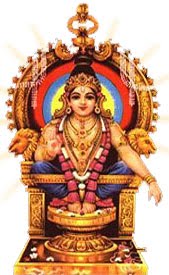சபரிமலை தீ விபத்து !
குறிப்பு : இந்த கட்டுரை என்னுடைய (V. அரவிந்த் ஸுப்ரமண்யம்) கல்லூரி நாட்களில் விஜய பாரதம் பத்திரிகையில் "" என்ற புனைப்பெயரில் எழுதப்பட்டது.
இன்று அதனை மீண்டும் பதிவு செய்கிறேன் - சிற்சில கூடுதல் தகவல்களோடு.
ஸ்வாமி சரணம்
V. அரவிந்த் ஸுப்ரமண்யம்
______________________________________________________________________________
உலகமே போற்றும் உன்னதக் கோவிலாம் சபரிமலையின் பெருமையை பற்றி புதிதாக விளக்க வேண்டிய அவசியமில்லை...
ஆனால் சுமார் 60 ஆண்டுகளுக்கு முன் சபரிமலையில் நடைபெற்ற ஒரு முக்கியமான சம்பவத்தை இன்றைய தலைமுறையினர் அறிந்திருக்க மாட்டார்கள்.
அன்றைய திருவிதாங்கூர் மாநிலம் (எனப்படும் Travancore State) கேரளத்தில், கேரள மாநிலம் மட்டுமல்லாது உலகெங்குமுள்ள ஹிந்து சமுதாயமே மனம் கொந்தளித்து நிற்குமளவுக்கு ஒரு சம்பவம் நடைபெற்றது..
 ஆம் ! பக்தர்கள் நினைத்தாலே பரவசத்தை கொடுக்கும் சபரிமலையின் ஆலயம் முற்றிலும் தீக்கிரையாக்கப்பட்டு தரைமட்டமாக்கப்பட்டிருந்தது...
ஆம் ! பக்தர்கள் நினைத்தாலே பரவசத்தை கொடுக்கும் சபரிமலையின் ஆலயம் முற்றிலும் தீக்கிரையாக்கப்பட்டு தரைமட்டமாக்கப்பட்டிருந்தது...விசாரணை நடத்த வந்த காவல்துறை கூட ஒருகணம் ஸ்தம்பித்து நின்று விட்டது..
கோவில் மூலஸ்தான கதவுகள் உடைத்து நொறுக்கப்பட்டிருந்தது... ஆலயக் கூரையும், ப்ராகாரமும் மரத்தால் செய்யப்பட்டவையாதலால் அவை கரிக்கட்டைகளாகவும் சாம்பற் குவியல்களாகவுமே எங்கும் சிதறிக் கிடந்தது... உள்ளே... ஐயப்பனின் திருமேனி (முன்பு ஆலயத்தில் ப்ரதிஷ்டை செய்யப்பட்டிருந்தது) துண்டு துண்டுகளாக நொறுக்கப்பட்டு எங்கும் சிதறிக் கிடந்தது....
காட்டுத்தீயினால் உண்டான விபத்து என்றே அனைவரும் நினைத்திருந்த நிலையில், காவல்துறை தன் விசாரணையை துவங்கியதும் அவர்கள் கண்டறிந்த உண்மை... எரிந்து போயிருந்த ஆலயத்தில் கிடைத்த நெய்யில் நனைக்கப்பட்ட தீப்பந்தங்களும்... ஆலயக்கதவுகளில் காணப்பட்ட கோடாலி அடையாளங்களும்... இது விபத்தல்ல என்று திட்டவட்டமாக உறுதி செய்தது.
 ஐயப்பன் எனும் தெய்வத்தை நாடி ஆண்டுக்கு ஆண்டு பக்தர்கூட்டம் அதிகரித்து வருவதை சிலர் விரும்பவில்லை. சாதிமத வித்யாசமில்லாமல் எல்லா மதத்தவரும் சபரிமலைக்கு வருவதை பொறுக்க முடியாமல், சபரிமலை கோவிலையே அழித்து விட்டால் அத்துடன் அங்கு வரும் பக்தர் கூட்டமும் ஐயப்ப பக்தியும் அழிந்து வ்டும் என்று எண்ணி இந்த சதிச்செயல் அரங்கேறி இருப்பது தெரிய வந்தது.
ஐயப்பன் எனும் தெய்வத்தை நாடி ஆண்டுக்கு ஆண்டு பக்தர்கூட்டம் அதிகரித்து வருவதை சிலர் விரும்பவில்லை. சாதிமத வித்யாசமில்லாமல் எல்லா மதத்தவரும் சபரிமலைக்கு வருவதை பொறுக்க முடியாமல், சபரிமலை கோவிலையே அழித்து விட்டால் அத்துடன் அங்கு வரும் பக்தர் கூட்டமும் ஐயப்ப பக்தியும் அழிந்து வ்டும் என்று எண்ணி இந்த சதிச்செயல் அரங்கேறி இருப்பது தெரிய வந்தது. விசாரணை தீவிரமடைய துவங்கிய நிலையில், மெல்ல மெல்ல உண்மை புலப்படலாயிற்று. ஒரு குறிப்பிட்ட பெயர் மட்டுமே கேட்கலாயிற்று...
"கோடாலி சாமி "
கோடாலி சாமியை அன்றைய சபரிமலை பக்தர்கள் அனைவருமே அறிந்திருந்தார்கள்... சில காலமாகவே அவன் சபரிமலையைச் சுற்றியே தான் வாழ்ந்து வந்தான்... உலலெங்கும் விபூதியை பூசியபடி அங்கு ஒரு மரப்பொந்தில் அமர்ந்திருக்கும் அவன், அங்கு வரும் பக்தர்களிடம் யாசகம் பெற்று வந்தான். எப்போதும் ஒரு கோடாலியை கையில் வைத்திருப்பதால் அவன் கோடாலி சாமி என்று அழைக்கப்பட்டான்.
கோடாலி சாமியை தேடிய போது, தீ விபத்து உண்டான நாளிலிருந்தே அவனை காணவில்லை என்பது தெரிய வந்தது...
காவல்துறை தங்கள் அவனைக் குறித்து விசாரித்ததில் பல உண்மைகள் தெரிய வந்தது...
ஒரு முறை, சபரிமலையில் மாத பூஜைகள் முடிந்து ஆலயம் அடைக்கப்பட்ட பிறகு, இந்த கோடாலிசாமி.. பக்தர்கள் உயிர்போல போற்றும் பதினெட்டாம் படிகள் முன்பு ஒரு விலங்கினை கொன்று மாமிசம் சமைத்துக் கொண்டிருந்தான். இதனைக் கண்ட சில பக்தர்களும் வனவாசிகளும் அவனை பிடித்து வந்து காவல்துறையினர் வசம் ஒப்படைத்தார்கள்.
வனவிலங்குகளை கொன்றதற்காகவும், கோவிலின் புனிதத்தை கெடுத்ததற்காகவும் அவனுக்கு 2 ஆண்டு சிறை தண்டனை விதிக்கப்பட்டது. ஆனால் இப்படியொரு செயலை அவன் அங்கு செய்ததற்கான காரணத்தை அறியமுடியவில்லை....
2 ஆண்டுகள் கழித்து சிறையிலிருந்து வெளியான அவன் நேராக மீண்டும் சபரிமலையை நோக்கி வந்தான். இம்முறை அவனுக்கு செங்கன்னூரைச் சேர்ந்த சில பணக்கார முதலாளிகளின் துணையும் இருந்தது. ஆலயத்துக்கு வந்த அவனை பழைய பக்தர்கள் சிலர் அடையாளம் கண்டு கொண்டு விரட்ட முற்பட்டார்கள். இதனால் மறைந்துகொண்ட அவன்.. அந்த மாதத்து பூஜை முடிந்து ஆலயத்தை பூட்டும்வரை காத்திருந்தான். ஆலயம் பூட்டப்பட்டு பக்தர்கள் அனைவரும் சென்ற பிறகு, இந்த கொடியவன் தன் கோடாலியால் கோவில் கதவினை உடைக்க முற்பட்டான். பின்னர் மனம் பதைக்க வைக்கும் கொடூர செயலை அரங்கேற்றினான்... ஆலயத்தை தீக்கிரையாக்கி விட்டான்.
அவது சதிச்செயலுக்கு துணை நின்ற பணக்காரர்களின் உதவியுடன் எளிதில் அங்கிருந்து தப்பிச் சென்று விட்டான்.
கோடாலி சாமியை தேடி வந்த போலீசாருக்கு அவன் (அன்றைய ப்ரெஞ்ச் பகுதியான) புதுச்சேரியில் பதுங்கியிருப்பது தெரிய வந்தது.
விசாரணையை இன்னும் தீவிரப்படுத்தி அவனைக் குறித்து மேலும் தகவல்கள் தேடிய போது... பல திடுக்கிடும் உண்மைகள் தெரிய வந்தது...
உடலெங்கும் விபூதி பூச்சு.. கோடாலி சாமி என்று பெயர் கொண்ட அவன் உண்மையில் ஹிந்துவே அல்ல ! அவன் வேறு மதத்தவன்.
இந்தியப் பகுதியின் போலீசார் ப்ரெஞ்ச் பகுதிக்குள் சென்று அவனை கைது செய்ய முடியாமல் திணறியது.
இறுதியில் தந்திரமாக ஒரு வேலை செய்து, அவனை புதுச்சேரியை விட்டு இந்திய எல்லைக்குள் வரவழைத்து கைது செய்தது காவல் துறை.
இதற்குள் இந்திய குடியரசு வலுப்பெற்றது. கேரள அரசியலில் பல மாற்றங்கள் உருவானது.. பணமும், மற்ற தலையீடுகளும் சேர்ந்து அதுவரை மிக வேகமாக சென்று கொண்டிருந்த சபரிமலை வழக்கும், கொஞ்சம் கொஞ்சமாக தன் முக்கியத்துவத்தை இழக்கத் துவங்கி தாமதப்படுத்தப்பட்டது...
விசாரணை அதிகாரியும் மாற்றப்பட்டார்... பல இடங்களிலிருந்தும் வந்த "தலையீடுகள்" காரணமாக.. "கோடாலி சாமி நிரபராதி." என்று அறிவிக்கப்பட்டு விடுதலை செய்யப்பட்டான்.
“வேறு யாராவது இதை செய்திருக்கலாம்” என்று மட்டுமே கூறப்பட்ட நிலையில், கோடாலி சாமி மிக எளிதாக தப்பி விட்டான்.
இதன் பின்னர் சில வருடங்களுக்கு பிறகு...
அதே கோடாலிசாமி மீண்டும் தோன்றினான் !
தன்னை கைது செய்த அதிகாரியை அவர் இல்லத்துக்கே வந்து சந்தித்து ஆசி கூறினான்.
ஆம் !
அந்த கோடாலிசாமி இப்போது ஒரு மதபோதகராக காட்சி தந்தான். அப்படியே அவன் மறைந்தும் விட்டான்.
அதோடு சபரிமலை தீ விபத்தின் மர்மமும் மறைந்தே விட்டது.
ஆனால் எந்த காரணத்துக்காக இந்த சதிச்செயல் அரங்கேற்றப் பட்டதோ, அது நிறைவேறவில்லை. தீவிபத்தினால் ஆலயத்தின் புகழ் அழியவில்லை. மாறாக, சபரிமலையிலும் அற்புதமானதொரு புதிய விக்ரஹம் ப்ரதிஷ்டை செய்யப்பட்டு, ஐயனின் புகழ் முன்னிலும் பன்மடங்கு பெருக தொடங்கியது.
சற்றே யோசித்துப் பார்த்தால் - இந்த சதிச்செயலை ஐயன் அனுமதித்ததும் அவன் சங்கல்பமே என்றே தோன்றுகிறது. அதுவரை தென்னாட்டில் மட்டுமே பெரிதும் அறியபட்டிருந்த ஆலயம் இதன் பின்னர் உலக மக்களெங்கும் அறியக் காரணமானது.
கோடாலிசாமியும், அவனுக்கு துணை நின்றவர்களும் சட்டத்தின் பிடியிலிருந்து தப்பினாலும் தெய்வத்தின் நீதியிலிருந்து தப்பவில்லை. பெரும் முதலாளிகளாக வலம்வந்த அத்தனைபேரும் உடல்நலம், மனநலம் குன்றி,செல்வ வளத்தையும் இழந்து இறுதியில் தங்கள் தவற்றை உணர்ந்து, ஐயப்பனிடமே சரண் புகுந்து, இன்று வரை அவர்கள் சந்ததியினர் சபரிமலைக்கு இருமுடிகட்டி வந்து கொண்டு இருக்கிறார்கள்.
அதுவரை நூற்றுக்கணக்கில் வந்து கொன்டிருந்த பக்தர்கள் கூட்டம் ஆயிரம், லட்சம், கோடி என பெருகி இன்று ஸ்வாமியே சரணம் ஐயப்பா என்ற கோஷம் உலகின் எல்லா மூலை முடுக்குகளிலும் கேட்கிறது.
ஆர் ஆறிவார் உன் மாயா லீலைகள் ஹரிஹர நந்தனனே ?








